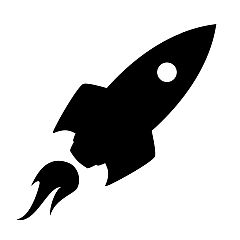A rudder is a primary control surface used to steer a ship, boat, submarine, hovercraft, aircraft, or other vehicle that moves through a fluid medium (generally air or water).
In the aerospace context, the rudder is a primary flight control surface located on the tail section of an aircraft, usually at the rear of the fuselage, that is used to control the yaw of the aircraft. The yaw is the rotation of the aircraft around the vertical axis and it's responsible for the change in the direction that the aircraft is pointing.
The rudder is typically controlled by the pilot using the rudder pedals in the cockpit. When the pilot pushes on the left rudder pedal, for example, the rudder on the tail of the aircraft moves to the left, causing the aircraft to yaw to the left.
One example of the use of rudder in aerospace is in the control of an aircraft during takeoff and landing. The pilot uses the rudder to align the aircraft with the runway and to maintain its heading during the takeoff and landing roll.
Another example is when an aircraft is in a flight, the pilot uses the rudder to maintain the aircraft's heading, or to make coordinated turns with the ailerons and elevators. In some cases, the rudder is used in combination with other control surfaces, such as the ailerons, to execute maneuvers like coordinated turns and slips.
Additionally, rudder is also used as a secondary control surface during an engine failure, allowing the pilot to maintain control of the aircraft and make a safe landing.
Related Articles to the term 'Rudder' | |
| 'Rudder' at maritime-glossary.com | ■■■■■■■■■ |
| Rudder in the maritime context refers to a flat, movable surface attached to the stern (rear) of a ship . . . Read More | |
| 'Steering' at maritime-glossary.com | ■■■■■■■■ |
| Steering in the maritime context refers to the process of controlling the direction of a ship or boat. . . . Read More | |
| 'Torque' | ■■■■■■■ |
| Torque: In physics and mechanics, torque is a standard mechanical quantity, the rotational equivalent . . . Read More | |
| 'Lift' | ■■■■■■■ |
| Lift: In the aerospace context, lift is the force that acts on an aircraft and enables it to rise into . . . Read More | |
| 'Rear' at maritime-glossary.com | ■■■■■■ |
| Rear: In the maritime context, the rear refers to the back part of a ship or vessel, commonly known as . . . Read More | |
| 'Aileron' | ■■■■■■ |
| Aileron: An aileron is a control surface typically found on the wings of an aircraft that enables it . . . Read More | |
| 'Airfoil' | ■■■■■■ |
| Airfoil: An airfoil is a shape designed to generate lift when air flows over it, commonly used in the . . . Read More | |
| 'Hovercraft' at maritime-glossary.com | ■■■■■■ |
| Hovercraft in the maritime context refers to a versatile vehicle that can travel over water, land, mud, . . . Read More | |
| 'Active Flow Control' | ■■■■■■ |
| Active Flow Control (AFC) in the Space industry refers to techniques and technologies used to manipulate . . . Read More | |
| 'Waterline' at maritime-glossary.com | ■■■■■■ |
| Waterline in the maritime context refers to the line where the hull of a ship or boat meets the surface . . . Read More | |
